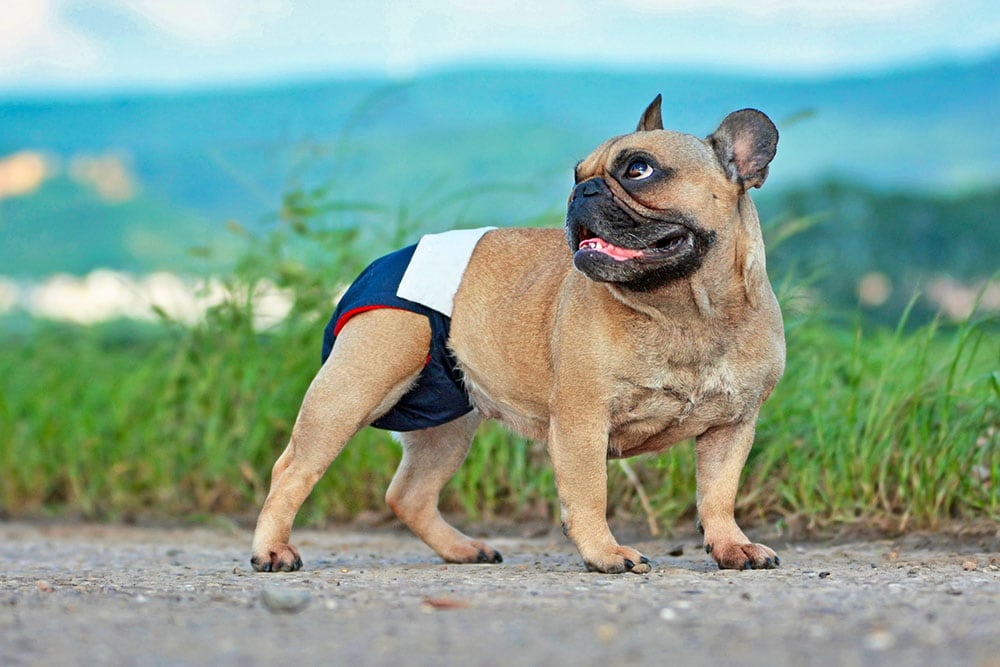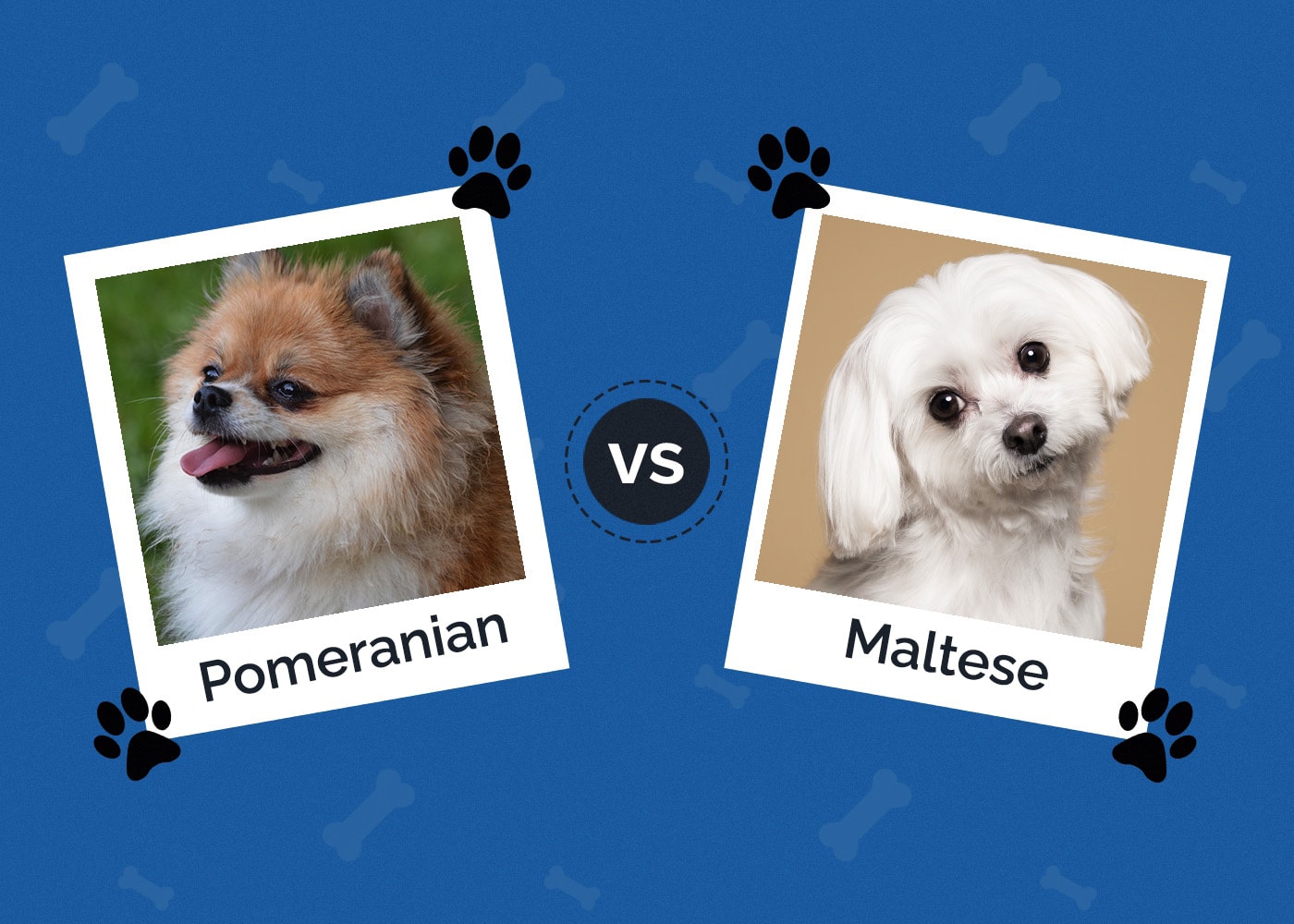Aussiedoodle vs Labradoodle: The Main Differences (With Pictures)

Updated on
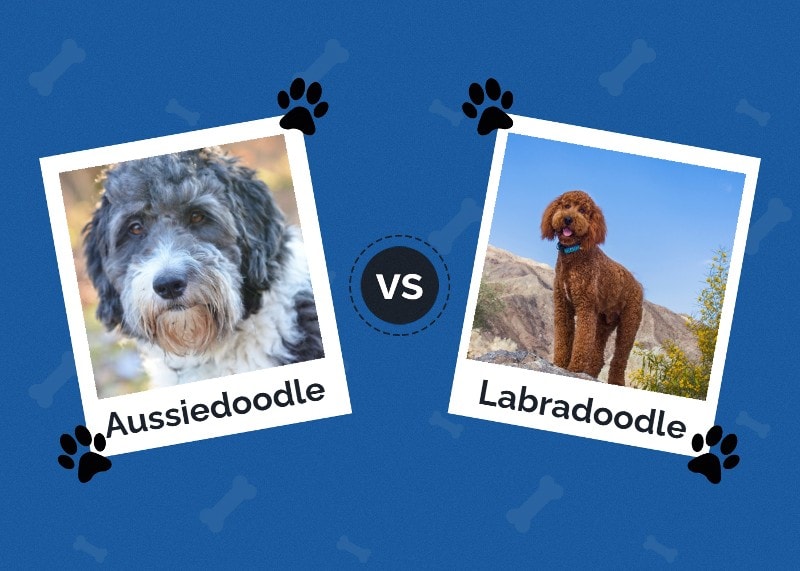
Click to Skip Ahead
Are you looking for a furry, four-legged friend to add to your family? With so many different breeds out there, it can be tough to decide which one is right for you. If you’re considering a Doodle breed, you may be wondering about the differences between an Aussiedoodle and a Labradoodle. These two breeds are both popular choices for their intelligence, personality, and hypoallergenic coats.
We’ll cover everything from their temperament and exercise needs to grooming requirements and trainability, and everything else you need to know to choose the best furry friend for your lifestyle and preferences.
Visual Differences

At a Glance
- Average height (adult): 15–25 inches
- Average weight (adult): 45–70 pounds
- Lifespan: 15–15 years
- Exercise: 1 to 2 hours per day
- Grooming needs: High
- Family-friendly: Yes
- Other pet-friendly: yes
- Trainability: Easy
- Average height (adult): 22–24 inches
- Average weight (adult): 50–65 pounds
- Lifespan: 12–15 years
- Exercise: At least 1 hour per day
- Grooming needs: High
- Family-friendly: Yes
- Other pet-friendly: Yes
- Trainability: Easy
Aussiedoodle Overview
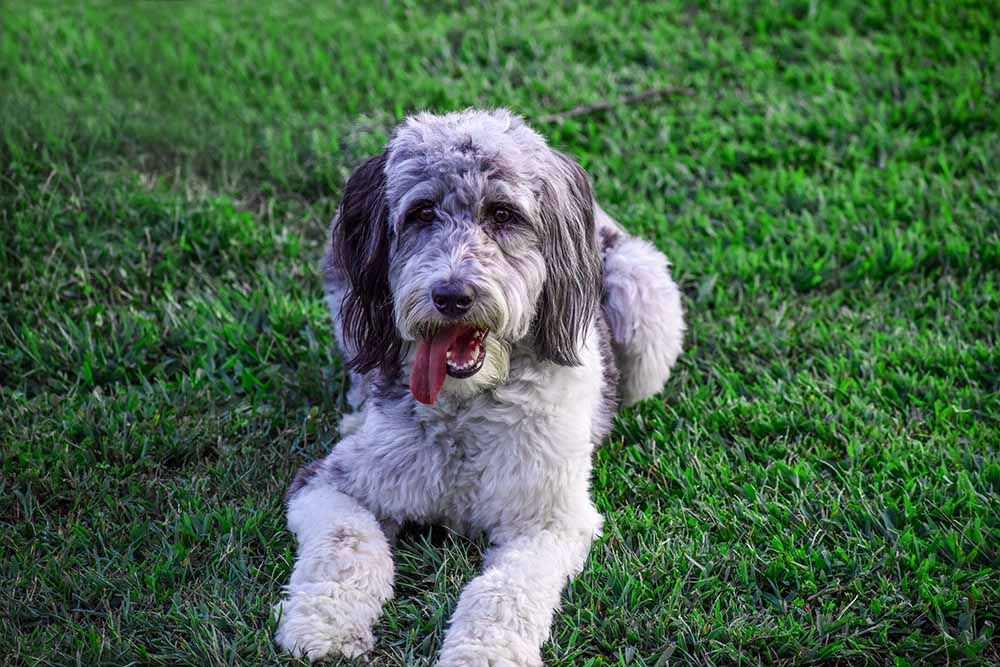
The Aussiedoodle, also known as the “Aussiepoo”, was first bred in the United States, by crossing an Australian Shepherd with a Poodle. Like the Labradoodle, the Aussiedoodle was developed as a hypoallergenic service dog, but it quickly became popular as a companion pet as well. Aussiedoodles are known for their intelligence, energy, and affectionate nature, and are a great choice for active families.
Breed Recognition
While Aussiedoodles are not recognized by the American Kennel Club (AKC) as a distinct breed, they are recognized by other organizations such as the International Designer Canine Registry (IDCR) and the Designer Dogs Kennel Club (DDKC).
Physical Appearance
Typically, Aussiedoodles have a curly or super wavy topcoat that ranges from medium to long in length. They can come in a variety of colors, including black, white, blue merle, red, and chocolate. One of the most distinctive features of this breed is their expressive eyes, which can be blue, brown, or one of each. These medium-sized dogs are also known for their athletic build, with a muscular body and a broad chest.
Personality
One of the most appealing traits of Aussiedoodle dogs is their playful and affectionate personalities. They’re known for being loyal and devoted to their owners, and they thrive on human interaction. Aussiedoodles are also easy to train and very smart, which makes them great pets for families who want a dog that can learn new tricks and commands quickly.
Another aspect of the Aussiedoodle’s personality that makes them such great companions is their energetic nature. They love to play and run around, which makes them great pets for active families. However, because they are so energetic, they do require a lot of exercise to keep them happy and healthy. It’s also worth noting that while Aussiedoodles are generally friendly and outgoing, they can be somewhat reserved around strangers.
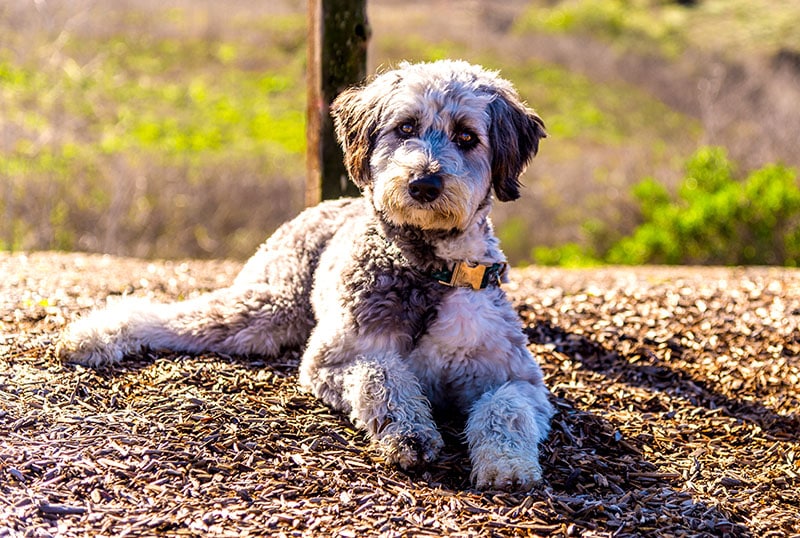
Training
Aussiedoodles are smart but they require proper training to ensure they are well-behaved and obedient. The key to training an Aussiedoodle is to start early and be consistent with your training methods. Positive reinforcement techniques such as rewards, praise, and treats are highly effective in training these pups.
Additionally, socialization is crucial for Aussiedoodles as they tend to be wary of strangers. Exposing your dog to different environments, people, and other animals from a young age will help them become confident and well-adjusted dogs.
Common Health Issues
As with any breed of dog, Aussiedoodles are prone to certain health conditions that you should be aware of before bringing one home. Some of the most common health concerns that affect Aussiedoodles include hip dysplasia, eye problems, and allergies.
Hip Dysplasia
Hip dysplasia is a common condition that affects many breeds of dogs, including Aussiedoodles. It is characterized by an abnormal formation of the hip joint, which can cause pain and stiffness. To reduce the risk of your Lab getting hip dysplasia, be sure to purchase your Doodle from a reputable dog breeder that actually checks all their dogs for this condition.
Eye Problems
Aussiedoodles are also prone to eye problems, including cataracts and progressive retinal atrophy (PRA). Both of these conditions can lead to vision loss if left untreated, so it’s important to have your Lab’s eyes checked once or twice a year by your vet.
Allergies
Finally, Aussiedoodles are sometimes prone to allergies, which can cause skin irritation and other symptoms. If you notice that your dog is scratching or licking excessively, it’s important to take them to the vet to determine the cause.
Puppy Cost
Owning an Aussiedoodle comes at a cost, and it’s important to understand what that cost entails before making the decision to bring one home. When it comes to puppies, the cost of an Aussiedoodle can vary depending on a variety of factors such as the breeder, location, and the puppy’s pedigree. Generally, you can expect to pay anywhere from $1,500 to $3,000 for a quality Aussiedoodle puppy.
This cost may seem steep, but it’s important to remember that investing in a reputable breeder can ultimately save you money in the long run by reducing the likelihood of health issues and behavioral problems. Additionally, Aussiedoodles require regular grooming, training, and veterinary care, which can add to the overall cost of ownership – so be ready for this as well.
- Related Read: How Much Does an Aussiedoodle Cost?

Suitable for:
Aussiedoodles are best for large or small families. These pups are friendly, affectionate, and good with children. They’re also great for active owners who enjoy outdoor activities such as hiking, running, agility courses, interactive toys, and swimming. It’s important to note that these styles are especially active, and it may take a bit to keep up with them if you aren’t someone who is active and mobile.
Labradoodle Overview
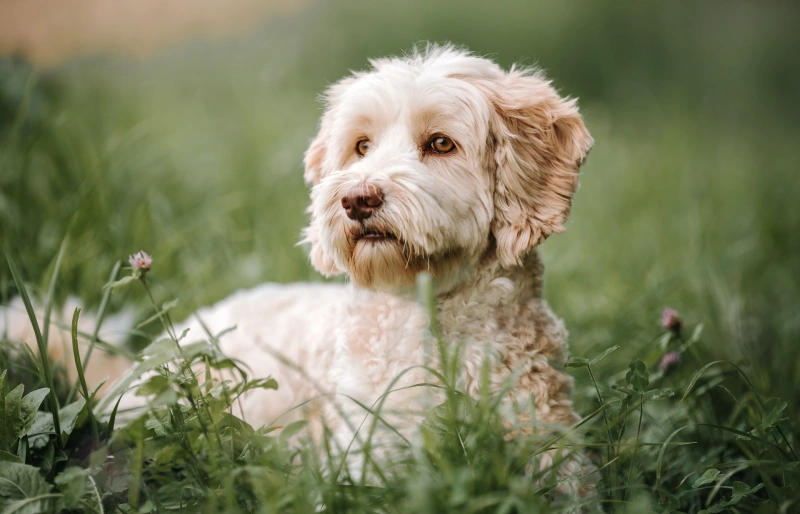
The Labradoodle was first bred in Australia, by crossing a Labrador Retriever with a Poodle. The breed quickly gained popularity for its friendly, outgoing personality, and its ability to work as a service dog for people with allergies. Today, Labradoodles are recognized by many kennel clubs and are a popular choice for families and individuals alike.
Breed Recognition
While some organizations recognize Labradoodles as a breed, others do not, which can lead to discrepancies in breed standards and regulations. Breed recognition of Labradoodles has been a controversial topic in the dog breeding community for many years.
Labradoodles were originally bred as hypoallergenic guide dogs for visually impaired individuals, but they’ve since gained popularity as family pets due to their friendly and affectionate nature. However, their hybrid status has caused confusion among breeders and dog enthusiasts alike. Despite this, Labradoodles continue to be a beloved and sought-after breed by many.
Physical Appearance
The physical appearance of a Labradoodle can vary greatly depending on the size and coat type of the poodle parent. Generally, Labradoodles have a soft, wavy or curly coat that can range in color from cream, tan, or white to gray or black. They have a medium, muscular build and can weigh anywhere from 50 to 65 pounds or more. Their ears are long and floppy, and their eyes are large and expressive like most Labs.
Personality
This breed is a highly intelligent and friendly dog with a lively personality. Labradoodles are known for their affectionate, active (though more laid back than Aussiedoodles), and super loyal nature, making them an excellent choice for families and individuals alike.
They’re also highly trainable and eager to please, making them an ideal choice for those looking for a dog that can be trained for various tasks (like service dogs). Labradoodles are also highly social and enjoy spending time with their families, making them an excellent companion for those who enjoy an active lifestyle.

Training
Older Labradoodles can be stubborn and demanding. Even if that means they have to take it away from you, they will make sure they get what they want. So, these energetic pups require consistent training from an early age to ensure they grow up to be well-behaved and obedient companions (or they may run over you).
One of the most important tips for training a Labradoodle is to establish a routine and stick to it. This can include things like a regular feeding schedule, exercise routine, and training sessions. Positive reinforcement is also key when training a Labradoodle, as they respond well to praise and rewards. Consistency, patience, and persistence are also important traits to have when training a Labradoodle, as it can take time and effort to fully train these smart pups.
Health & Care
Labradoodles are a relatively new breed that has gained immense popularity due to their cute looks and great personality. However, like any other Lab breed, their most common health issues include hip dysplasia, ear infections, allergies, and eye problems.
Hip Dysplasia
Hip dysplasia is a genetic condition that affects the hip joint, causing pain and discomfort in the affected dog. It is more common in larger breeds like Labradoodles and may require surgery or medication to manage. Ear infections are another common health issue in Labradoodles, especially those with floppy ears. Regular ear cleaning and check-ups with a vet can help prevent or manage this condition.
Allergies
Allergies, both food, and environmental, are also common in Labradoodles. These dogs may experience itching, rashes, and gastrointestinal issues due to food allergies, while environmental allergies may cause respiratory problems, skin issues, and more.
Eye Problems
Like with Aussiedoodles, Labradoodles can also be prone to issues with their eyes. Eye problems like cataracts, glaucoma, and progressive retinal atrophy can also affect this breed, leading to vision loss or blindness if left untreated.
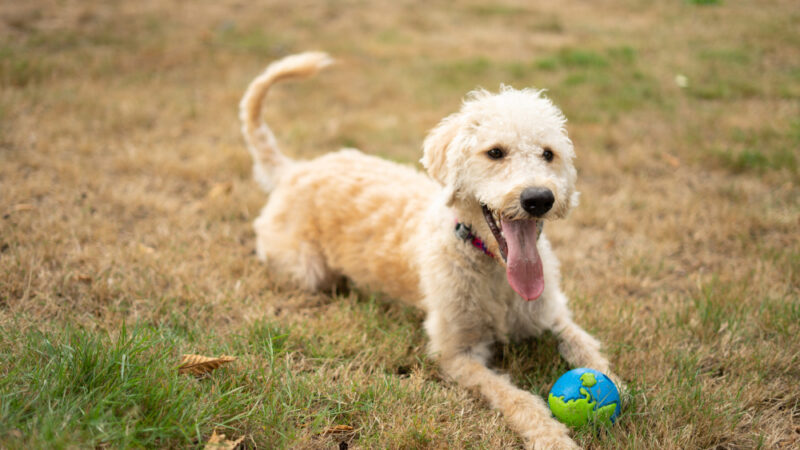
Puppy Cost
The cost of a Labradoodle puppy can vary depending on a number of factors including the breeder, location, and the lineage of the puppy. Like with Aussiedoodles, you can expect to pay between $1,500 and $3,000 for a Labradoodle puppy and it’s easier to purchase them in the US.
However, it’s helpful to remember that the cost of the puppy is just the beginning of the expenses you will incur as a pet owner. You will also need to budget for food, toys, veterinary care, and grooming services. Additionally, it’s important to choose a reputable breeder who can provide you with a healthy and well-socialized puppy. By doing your research and planning ahead, you can ensure that you are prepared for the cost of owning a Labradoodle puppy.
Suitable for:
The best owners for Labradoodles are those who have the time, energy, and resources to provide them with the care and attention they need. Labradoodles require daily exercise (at least an hour) and mental stimulation. They’re very active dogs that love to play and explore, so owners who are able to provide them with plenty of opportunities for physical and mental activity are ideal. This includes taking them for walks, playing fetch, and engaging them in training and puzzle games. That being stated, they’re a tad more laid back than Aussiedoodles.
Also, Labradoodles need a lot of attention and affection. They are social animals that crave human interaction and can suffer from separation anxiety if left alone for long periods of time. Owners who are able to spend time with their Labradoodle and provide them with plenty of love and attention are best suited for this breed.
Which Breed Is Right for You?
Well, it depends. While they may look similar at first glance, there are some key differences between the two that can help you decide which one is best for you.
Aussiedoodles are a mix between Australian Shepherds and Poodles, while Labradoodles are a combination of Labrador Retrievers and Poodles. Both breeds are known for being smart, very friendly, and easy to train, making them great family pets.
But Aussiedoodles tend to be slightly smaller than Labradoodles. They have a curlier coat and they’re also known for being more active and high-energy, making them a great choice for families who enjoy hiking, running, or other outdoor activities. However, they may be more prone to separation anxiety and require more exercise and mental stimulation than some other breeds.
Labradoodles, on the other hand, are typically a bit larger with a wavy or straight coat that may shed more than an Aussiedoodle. They’re generally more laid-back and easy-going, making them a good option for families with young children or those who prefer a more relaxed lifestyle. However, they may require more grooming to keep their coat looking tidy.
Ultimately, the decision between an Aussiedoodle and a Labradoodle comes down to your individual preferences and lifestyle. Both breeds have their unique pros and cons, and it’s helpful to first consider factors like energy level, coat type, and size before making a decision.
See also:
- Sheepadoodle vs Labradoodle: Which One Is Right for Me?
- Cavapoo Vs. Labradoodle: All the Differences (With Pictures)
Featured Image Credit: (L) Claudia Naerdemann, Shutterstock | (R) Danita Delimont, Shutterstock




